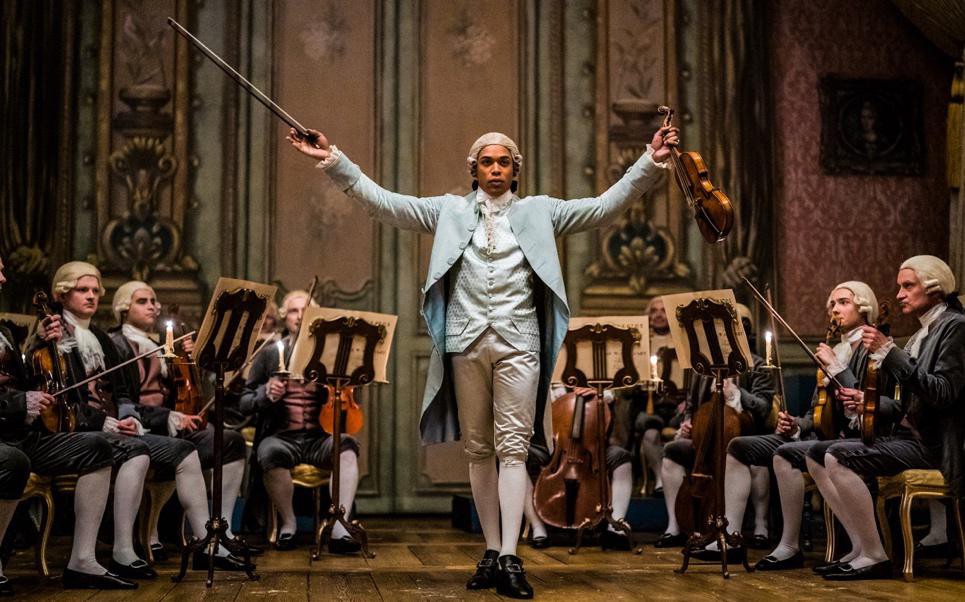By Dwight Brown
NNPA Film Critic
(***1/2) It’s not the same as it was. This retelling of 18th century French violinist-composer Joseph Bologne, Chevalier de Saint-Georges’ life is steeped in history but rocked with a modern imagination.
Screenwriter Stefani Robinson’s (“Atlanta”) research and ingenuity resurrects Bologne (Kelvin Harris Jr.) as a European superstar, given the honorary title Chevalier de Saint-Georges. Queen Marie Antoinette (Lucy Boynton) confers him an officer of the King’s Guard and welcomes the mixed-race artist into her court.
It’s quite an ascension for a Creole child born in 1745 on the Caribbean isle of Guadalupe, son of a teen slave named Nanon (Ronke Adekoluejo) and a white French plantation owner. Joseph, as a boy (Reuben Anderson) and violin virtuoso, is torn from his mother, brought to France by his father and left at the La Boëssière Academy. There he studies music, math, literature, and fencing with the sons of white aristocrats. Not that it is easy — Emotionally, psychologically and physically, he’s abused.

Years later, Joseph Bologne is a champion fencer who stabs his competitors and pierces their egos. He also plays the violin like it’s an extension of his being and is so sure of himself he challenges Mozart to a violin duel. In a crowded concert hall, his virtuosity embarrasses Wolfgang Amadeus. That success and being embraced by the Queen gives him confidence but not security. He flirts with high society but is stymied by France’s Code Noir, a set of laws regarding slavery that hinder Black people from gaining status or class.
Competing to be the head of the Paris Opera exacerbates Joseph’s very weighted struggles.
When his mother comes to stay and the proletariats rebel against the Queen’s iron grip, he finds his bearings. The immigrants and workers edging towards liberty inspire him. Nanon helps him see the errors of his superficial lux life after he buys her expensive made-to-order clothes: “All the money you paid for those dresses could have fed the whole city.”
Robinson’s blend of fact and fiction with hints of today’s racial/identity issues are thoughtful. The composer’s works were banned by Napoleon, and details about him are skimpy, compared to a Mozart, so fabrication is necessary and useful. Her intellectual and emotional grasp of injustices in today’s world and what must have been unfairness in 18th century Europe seem perceptive and intuitive. Indignities and life ironies are seen and also heard in profound dialogue. As Joseph fathoms the complexities of marriage, he states his paradox: “Can’t marry a white woman of my class, and if I marry a black woman, I will lose my class.”
The Chevalier/Mozart face-off never happened. It’s just one of many melodramatic devices designed to draw today’s audience into the complex world Bologne encountered and thrived in, until he didn’t. His friend and advocate Philippe (Alex Fitzalan) is an activist. A love affair with the chanteuse Marie-Josephine de Comarieu (Samara Weaving) blossoms. Powerplays with her jealous husband Marquise De Montalembert (Marton Csokas) hint at danger, and being trolled by a lecherous, vindictive prima donna (Minnie Driver) leads to sabotage. These subplots and characters fill out the violinist’s story.
Emmy Award-winning director Stephen Williams (“Watchman”) uses Robinson’s script as if it’s a sketch for an oil painting. He adds color, movement, details and style, recreating 18th century Paris/Versailles as vividly as any artist could. Shonda Rhimes’ popular Netflix series “Bridgerton” set the precedent for historic multiculturally cast dramas. So, what’s on view feels natural.
Under Williams’ guidance, the visuals are flawless, evocative and beautiful. Costume designer Oliver Garcia (“The Favourite”) uses tones, patterns and textures impeccably on clothes that are natty and so French. Salons, concert halls and boudoirs feign places where the rich and snooty congregate (production designer Karen Murphy, “A Star is Born”), nothing looks out of place (set decorator Lotty Sanna) and the spectrum of colors aptly recreate the period’s aesthetics (art director Gemma Randall).
As your eyes peruse France, the camera (Jess Hall, “Brideshead Revisited”) is perfectly placed, from a distance or up close. During opera or symphony scenes, performances and audience reactions are neatly clipped together making the footage fresh and kinetic (editor John Axelrad, “The Lost City of Z”), not staid and stodgy. Between Robinson’s use of spicey language (f—k), Williams’ vibrant direction, the populous rebellion and the rhythmic pacing, the film starts with a zest and maintains a quixotic feel for 1h 47m.
Harris does a great job displaying the angst and bravery of a man straddling two worlds. Understated for the most part but ready to roar, when necessary. E.g., when he confronts the deceptive Marie Antoinette: “Your people are starving in the streets! You are a traitor, a fraud!”
Adekoluejo, as his knowing mom weaving the lover, Boynton, the shallow Queen, and Csokas, as a belligerent officer, are all as wonderful or disdainful as they should be.
The violin is the scene stealer. Legato, staccato, solo, or flanked by other instruments, its sounds are wondrous as it performs the composer’s music (updated by Michael Abels) or the entrancing score by Kris Bowers (“Green Book,” “King Richard,”) especially in the final concert (“Violin Concerto No. 9”). Its only competition is a cello that moans during Joseph and Marie-Josephine’s first kiss scene. Musically, it will be hard for audiences to distinguish what once was and what is new.
“Chevalier” is a fitting coda for an artist who deserved a biofilm. In this world, it’s enough. Framing a story, the same as it was or should have been, it’s enough.
In theaters April 21st.
Visit NNPA News Wire Film Critic Dwight Brown at DwightBrownInk.com.




